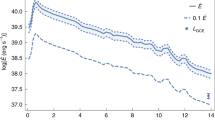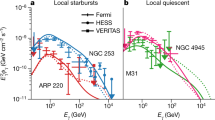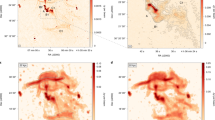Abstract
An anomalous gamma-ray excess emission has been found in the Fermi Large Area Telescope data1 covering the centre of the Galaxy2,3. Several theories have been proposed for this ‘Galactic centre excess’. They include self-annihilation of dark-matter particles4, an unresolved population of millisecond pulsars5, an unresolved population of young pulsars6, or a series of burst events7. Here, we report on an analysis that exploits hydrodynamical modelling to register the position of interstellar gas associated with diffuse Galactic gamma-ray emission. We find evidence that the Galactic centre excess gamma rays are statistically better described by the stellar over-density in the Galactic bulge and the nuclear stellar bulge, rather than a spherical excess. Given its non-spherical nature, we argue that the Galactic centre excess is not a dark-matter phenomenon but rather associated with the stellar population of the Galactic bulge and the nuclear bulge.
This is a preview of subscription content, access via your institution
Access options
Access Nature and 54 other Nature Portfolio journals
Get Nature+, our best-value online-access subscription
$29.99 / 30 days
cancel any time
Subscribe to this journal
Receive 12 digital issues and online access to articles
$119.00 per year
only $9.92 per issue
Buy this article
- Purchase on Springer Link
- Instant access to full article PDF
Prices may be subject to local taxes which are calculated during checkout


Similar content being viewed by others
References
Atwood, W. B. et al. The Large Area Telescope on the Fermi Gamma-Ray Space Telescope mission. Astrophys. J. 697, 1071–1102 (2009).
Goodenough, L. & Hooper, D. Possible evidence for dark matter annihilation in the inner Milky Way from the Fermi Gamma Ray Space Telescope. Preprint at http://arxiv.org/abs/0910.2998 (2009).
Ackermann, M. et al. The Fermi Galactic Center GeV excess and implications for dark matter. Astrophys. J. 840, 43 (2017).
Calore, F., Cholis, I. & Weniger, C. Background model systematics for the Fermi GeV excess. J. Cosm. Astropart. Phys. 3, 38 (2015).
Abazajian, K. N. & Kaplinghat, M. Detection of a gamma-ray source in the Galactic Center consistent with extended emission from dark matter annihilation and concentrated astrophysical emission. Phys. Rev. D 86, 083511 (2012).
O’Leary, R. M., Kistler, M. D., Kerr, M. & Dexter, J. Young pulsars and the Galactic Center GeV gamma-ray excess. Preprint at http://arXiv.org/abs/1504.02477 (2015).
Cholis, I. et al. The Galactic Center GeV excess from a series of leptonic cosmic-ray outbursts. J. Cosm. Astropart. Phys. 12, 005 (2015).
Acero, F. et al. Development of the model of Galactic interstellar emission for standard point-source analysis of Fermi Large Area Telescope data. Astrophys. J. Suppl. 223, 26 (2016).
Macias, O. & Gordon, C. Contribution of cosmic rays interacting with molecular clouds to the Galactic Center gamma-ray excess. Phys. Rev. D 89, 063515 (2014).
Pohl, M., Englmaier, P. & Bissantz, N. Three-dimensional distribution of molecular gas in the barred Milky Way. Astrophys. J. 677, 283–291 (2008).
Acero, F. et al. Fermi Large Area Telescope third source catalog. Astrophys. J. Suppl. 218, 23 (2015).
Keeley, R., Abazajian, K., Kwa, A., Rodd, N. & Safdi, B. What the Milky Way’s dwarfs tell us about the Galactic Center extended excess Preprint at http://arXiv.org/abs/1710.03215 (2017).
Lee, S. K., Lisanti, M., Safdi, B. R., Slatyer, T. R. & Xue, W. Evidence for unresolved γ -ray point sources in the inner galaxy. Phys. Rev. Lett. 116, 051103 (2016).
Bartels, R., Krishnamurthy, S. & Weniger, C. Strong support for the millisecond pulsar origin of the Galactic Center GeV excess. Phys. Rev. Lett. 116, 051102 (2016).
Horiuchi, S., Kaplinghat, M. & Kwa, A. Investigating the uniformity of the excess gamma rays towards the Galactic Center region. J. Cosm. Astropart. Phys. 1611, 053 (2016).
Ploeg, H., Gordon, C., Crocker, R. & Macias, O. Consistency between the luminosity function of resolved millisecond pulsars and the Galactic Center excess. J. Cosm. Astropart. Phys. 1708, 015 (2017).
Portail, M., Wegg, C. & Gerhard, O. Peanuts, brezels and bananas: food for thought on the orbital structure of the Galactic bulge. Mon. Not. R. Astron. Soc. 450, L66–L70 (2015).
Nataf, D. M., Udalski, A., Gould, A., Fouqué, P. & Stanek, K. Z. The split red clump of the Galactic Bulge from OGLE-III. Astrophys. J. Lett. 721, L28–L32 (2010).
Ness, M. & Lang, D. The X-shaped bulge of the Milky Way revealed by WISE. Astrophys. J. 152, 14 (2016).
Wright, E. L. et al. The Wide-field Infrared Survey Explorer (WISE): mission description and initial on-orbit performance. Astrophys. J. 140, 1868–1881 (2010).
Joo, S.-J., Lee, Y.-W. & Chung, C. New insight on the origin of the double red clump in the Milky Way bulge. Astrophys. J. 840, 98 (2017).
Launhardt, R., Zylka, R. & Mezger, P. G. The nuclear bulge of the Galaxy. III. Large-scale physical characteristics of stars and interstellar matter. Astron. Astrophys. 384, 112–139 (2002).
Nishiyama, S. et al. Magnetically confined interstellar hot plasma in the nuclear bulge of our Galaxy. Astrophys. J. Lett. 769, L28 (2013).
Ackermann, M. et al. The spectrum and morphology of the Fermi bubbles. Astrophys. J. 793, 64 (2014).
Su, M., Slatyer, T. R. & Finkbeiner, D. P. Giant gamma-ray bubbles from Fermi-LAT: active galactic nucleus activity or bipolar galactic wind? Astrophys. J. 724, 1044–1082 (2010).
Bland-Hawthorn, J. & Gerhard, O. The Galaxy in context: structural, kinematic, and integrated properties. Annu. Rev. Astron. Astrophys. 54, 529–596 (2016).
Winter, M., Zaharijas, G., Bechtol, K. & Vandenbroucke, J. Estimating the GeV emission of millisecond pulsars in dwarf spheroidal galaxies. Astrophys. J. 832, L6 (2016).
Abdo, A. A. et al. A population of gamma-ray emitting globular clusters seen with the Fermi Large Area Telescope. Astron. Astrophys. 524, A75 (2010).
Bartels, R., Storm, E., Weniger, C. & Calore, F. The Fermi-LAT GeV excess traces stellar mass in the Galactic bulge. Preprint at http://arXiv.org/abs/1711.04778 (2017).
Strong, A. W. et al. Galprop version 54: explanatory supplement. https://galprop.stanford.edu/download/manuals/galprop_v54.pdf (2011).
Ajello, M. et al. Fermi-LAT observations of high-energy γ-ray emission toward the Galactic center. Astrophys. J. 819, 44 (2016).
Nolan, P. L. et al. Fermi Large Area Telescope second source catalog. Astrophys. J. Suppl. 199, 31 (2012).
Mattox, J. et al. The likelihood analysis of EGRET data. Astrophys. J. 461, 396 (1996).
Wilks, S. S. The large-sample distribution of the likelihood ratio for testing composite hypotheses. Ann. Math. Stat. 9, 60 (1938).
Yang, R.-Z. & Aharonian, F. On the GeV excess in the diffuse γ-ray emission towards the Galactic centre. Astron. Astrophys. 589, A117 (2016).
Gordon, C. & Macias, O. Dark matter and pulsar model constraints from Galactic center Fermi-LAT gamma ray observations. Phys. Rev. D 88, 083521 (2013).
Manchester, R. N., Hobbs, G. B., Teoh, A. & Hobbs, M. The Australia Telescope National Facility pulsar catalogue. Astron. J. 129, 1993–2006 (2005).
Harris, W. E. A catalog of parameters for globular clusters in the Milky Way. Astron. J. 112, 1487 (1996).
Green, D. A. A catalogue of 294 Galactic supernova remnants. Bull. Astron. Soc. India 42, 47–58 (2014).
Massaro, E. et al. Roma-BZCAT: a multifrequency catalogue of blazars. Astron. Astrophys. 495, 691–696 (2009).
Fermi-LAT Collaboration Characterizing the population of pulsars in the Galactic bulge with the Fermi Large Area Telescope. Preprint at https://arxiv.org/abs/1705.00009 (2017).
Freudenreich, H. T. A COBE model of the Galactic bar and disk. Astrophys. J. 492, 495–510 (1998).
Hooper, D. & Linden, T. On the origin of the gamma rays from the Galactic center. Phys. Rev. D 84, 123005 (2011).
Abazajian, K. N., Canac, N., Horiuchi, S. & Kaplinghat, M. Astrophysical and dark matter interpretations of extended gamma-ray emission from the Galactic center. Phys. Rev. D 90, 023526 (2014).
Daylan, T. et al. The characterization of the gamma-ray signal from the central Milky Way: a case for annihilating dark matter. Phys. Dark Univ. 12, 1–23 (2016).
Self, S. G. & Liang, K.-Y. Asymptotic properties of maximum likelihood estimators and likelihood ratio tests under nonstandard conditions. J. Am. Stat. Assoc. 82, 605–610 (1987).
Ackermann, M. et al. Fermi-LAT observations of the diffuse gamma-ray emission: implications for cosmic rays and the interstellar medium. Astrophys. J. 750, 3 (2012).
Casandjian, J.-M. Local Hi emissivity measured with Fermi-LAT and implications for cosmic-ray spectra. Astrophys. J. 806, 240 (2015).
Acknowledgements
R.M.C. was the recipient of an Australian Research Council Future Fellowship (FT110100108). S.H. is supported by the U.S. Department of Energy, Office of Science, under award number de-sc0018327. We thank D. Lang for making available code and data that helped with generating the X-bulge template and both S. Nishiyama and K. Yasui for providing the data for the nuclear bulge template. We acknowledge the use of public data and software from the Fermi data archives (http://fermi.gsfc.nasa.gov/ssc/). Finally, the authors would also like to thank F. Aharonian, A. M. Brown, F. Calore, J.-M. Casandjian, H. T. Cromartie, S. Digel, T. Enßlin, M. Kaplinghat, K. Freeman, O. Gerhard, O. Gnedin, X. Huang, N. McClure-Griffiths, D. Nataf, H. Ploeg, B. Roberts, M. Winter, R. Tuffs and G. Zaharijas for enlightening discussions.
Author information
Authors and Affiliations
Contributions
O.M. designed and performed the majority of the data analysis. O.M. also constructed the Fermi bubbles, Sun, Moon, inverse Compton and Loop I templates. C.G. processed the WISE data and derived the mixture distribution formulas. R.M.C. suggested the link with the X-bulge. B.C. processed the hydrodynamical 3D map into annuli density maps. D.P. created the interpolated annuli density maps. C.G. and S.H. assisted with the point source modelling. B.C. and D.P. created the dust maps. M.P. created the 3D HI and CO maps. All authors contributed to the interpretation of the results. The text of the final manuscript was mainly written by O.M. and C.G., but all authors had some contribution.
Corresponding author
Ethics declarations
Competing interests
The authors declare no competing interests.
Additional information
Publisher’s note: Springer Nature remains neutral with regard to jurisdictional claims in published maps and institutional affiliations.
Supplementary information
Supplementary Information
Supplementary Sections 1–3, Supplementary Figures 1–10, Supplementary Tables 1–4
Supplementary Dataset 1
FITS version of Supplementary Table 1
Rights and permissions
About this article
Cite this article
Macias, O., Gordon, C., Crocker, R.M. et al. Galactic bulge preferred over dark matter for the Galactic centre gamma-ray excess. Nat Astron 2, 387–392 (2018). https://doi.org/10.1038/s41550-018-0414-3
Received:
Accepted:
Published:
Issue Date:
DOI: https://doi.org/10.1038/s41550-018-0414-3
This article is cited by
-
Limits on dark matter annihilation from the shape of radio emission in M31
Journal of High Energy Physics (2024)
-
Millisecond pulsars from accretion-induced collapse as the origin of the Galactic Centre gamma-ray excess signal
Nature Astronomy (2022)
-
Gamma-ray emission from the Sagittarius dwarf spheroidal galaxy due to millisecond pulsars
Nature Astronomy (2022)
-
Muonphilic dark matter explanation of gamma-ray galactic center excess: a comprehensive analysis
Journal of High Energy Physics (2022)
-
A closer look at CP-violating Higgs portal dark matter as a candidate for the GCE
Journal of High Energy Physics (2021)



